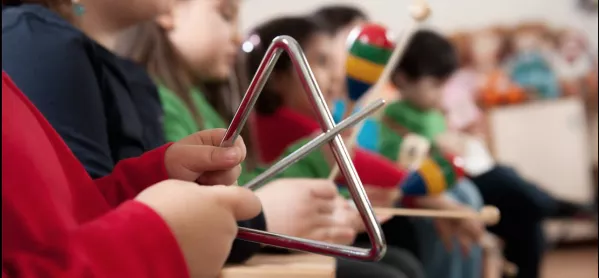How can the DfE help you best? Funding...or music?

How could the Department for Education help you right now?
Maybe some additional funding to replace the money your school has had to spend on paper towels and hand sanitiser? Or perhaps some clarity in the guidance about restarting sports clubs or transition arrangements for this summer?
I can’t say that I’ve heard many people crying out for a model music curriculum. But a model music curriculum is what we’ve got.
And what a treat. Apparently it’s going to lead to world-class teaching, just like that. Let’s hope it’s nothing like the world-class track and trace system or the world-class social care system they keep promising.
Model music curriculum: Words are cheap
As ever, words are cheap. And, in this case, it seems, so are actions. The limit of the government’s actions and investment appears to be producing the framework that the rest of us then are presumably supposed to turn into a reality.
From a primary teacher’s point of view, you’d be hard pushed to find a primary school that wouldn’t like to improve its music provision. For some schools, that will be getting their school choir to the next stage of the big competition; for others, it will be maintaining the cost of another year’s instrumental tuition. For some, it will be the desperate ambition to finally replace all the missing “F” chime bars and have enough beaters for one per child.
Instead, we get a document setting out how much better we should be at teaching music. And the prompt that we should be doing so for a minimum of an hour every week. Because if there’s one thing we know about primary schools, it’s that we’re always in need of things to fill up the timetable.
When I surveyed schools in the summer before the pandemic, the average amount of time allocated to music was just 35 minutes a week. I’m sure many would like to offer more, but the demands of the primary curriculum - and its accompanying assessment and accountability - doesn’t exactly lend itself to a varied curriculum.
Where’s the funding? And the training?
How long before we see more requirements set out like this? If we have 60 minutes for music, should we offer the same for art? For design and technology? For the newly statutory PSHE? And foreign languages. All those 60-minute slots soon add up.
No doubt, in some cases, the timetable is made to allow 60 minutes a week. Perhaps in some schools, they’re also ensuring that their Year 6 pupils can recognise Chopin’s Four Mazurkas and are able to compose a ternary piece with contrasts. But, in many others, such experiences will be unfamiliar to many Year 6 teachers.
Arguably, the whole point of a model curriculum should be to demonstrate the very highest standards possible, and in many ways this document does exactly that. I would be delighted if every child in my school had access to all of these experiences through their music teaching. But, sadly, it’s not as simple as writing it all down in a model document.
For a start, our Year 6 music teacher - the person responsible for delivering the final stages of this aspirational framework - is me. And, with my GCSE in music (grade C, just about, thank you very much), I’m also probably as well qualified as the typical primary school teacher. A quick poll over the weekend suggests that nearly three-quarters of us dropped music at the age of 13 or 14.
So, fine, let’s have a model curriculum drafted for every subject if that’s the way we’re going. But that’s the beginning of a long journey that’s going to need funding and training to follow. And the DfE seems to be strangely quiet on that front.
Michael Tidd is headteacher at East Preston Junior School in West Sussex. He tweets @MichaelT1979
You need a Tes subscription to read this article
Subscribe now to read this article and get other subscriber-only content:
- Unlimited access to all Tes magazine content
- Exclusive subscriber-only stories
- Award-winning email newsletters
Already a subscriber? Log in
You need a subscription to read this article
Subscribe now to read this article and get other subscriber-only content, including:
- Unlimited access to all Tes magazine content
- Exclusive subscriber-only stories
- Award-winning email newsletters
topics in this article



